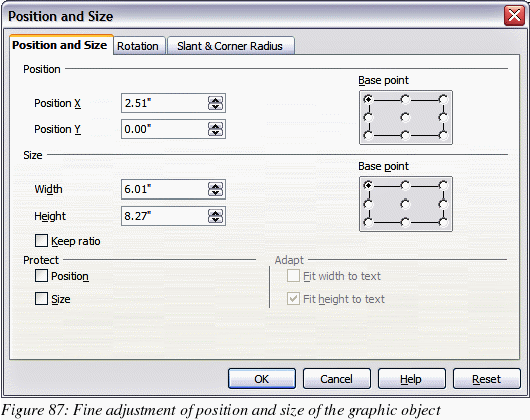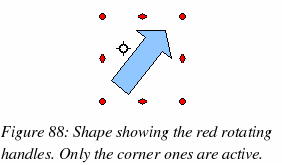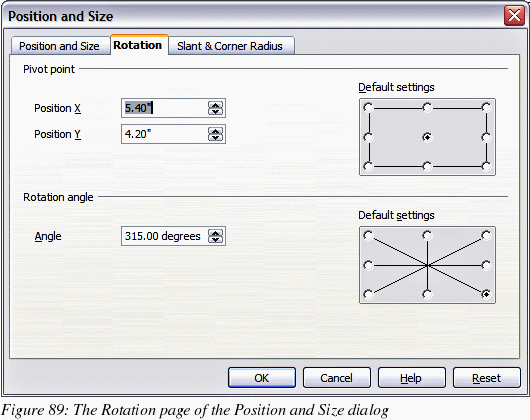Moving, resizing and rotating a graphic object
This
section describes the mechanisms that are available in Impress to
move, resize and rotate a graphic object. Note that the same
procedures can be applied equally to a picture (see Chapter 4) and
to a graphic (see Chapter 5).
Moving
graphic objects
Click
the graphic object, if necessary, to show the green resizing
handles.
Move
the pointer over the graphic object until the pointer changes
shape. On most operating systems, the cursor associated with moving
objects is a four-headed arrow, but it may also be a hand or some
other symbol.
Click
and drag the graphic object to the desired position.
Release
the mouse button.
For
a more accurate placement of the graphic object, use the Position
and Size dialog shown in Figure 87. To open this dialog, first
select the graphic object by clicking on it; when the resizing green
handles are displayed, either press F4
or select Format >
Position and Size from the menu bar.
Use
the Position
section of the dialog to specify the X (horizontal) and Y (vertical)
position of the graphic object. The values represent the distance of
the base point (selected on the right hand side of the dialog)
relative to the top left corner of the slide.
To
prevent accidental modification of the position of the graphic
object, select the Position
checkbox in the Protect
section (bottom left) of the dialog.
The
unit of measurement for this and the other dialogs in this section
is set in Tools > Options
> OpenOffice.org Impress >
General.

Resizing
graphic objects
Click
the graphic object, if necessary, to show the green resizing
handles.
Position
the pointer over one of the green resizing handles. The pointer
changes shape, giving a graphical representation of the direction
of the resizing.
Click
and drag to resize the graphic object.
Release
the mouse button when satisfied with the new size.
The
corner handles resize both the width and the height of the graphic
object simultaneously, while the other four handles only resize one
dimension at a time.
|
Tip
|
To
retain the original proportions of the graphic, Shift+click
one of the corner handles, then drag. Be sure to release the
mouse button before
releasing the Shift
key.
|
For
more accurate resizing of the graphic object, use the Position and
Size dialog (Figure 87). Select as the base point the part of the
graphic object that you would like to anchor to the page. The
default setting (top left corner) means that the when resizing the
area, the position of the top left corner of the area will not
change. Now modify either the Width
value or the Height
value of the object. To maintain the proportions between width and
height, select the Keep ratio
checkbox before modifying any value. Notice that when the checkbox
is selected both dimensions change simultaneously.
To
prevent accidental modifications of the size, make sure that the
Size checkbox is
selected in the Protect
section in the bottom left part of the dialog.
Rotating
graphic objects
As
for the position and the size, rotation of an object can be done
manually or using a dedicated dialog. To rotate a graphic manually,
do as follows:
Select
the graphic object if necessary so that the green handles around it
show.
Click
the Rotate button
 on the Drawing toolbar. This toolbar is usually located at the
bottom the screen, but it can be undocked and used as a floating
toolbar. If the toolbar is not showing, select View
> Toolbars > Drawing. The Drawing toolbar is
discussed in detail in Chapter 5.
on the Drawing toolbar. This toolbar is usually located at the
bottom the screen, but it can be undocked and used as a floating
toolbar. If the toolbar is not showing, select View
> Toolbars > Drawing. The Drawing toolbar is
discussed in detail in Chapter 5.
|
Note
|
The
icons representing the functions in the toolbars are different
depending on the operating system used and on whether OOo has
been customized for the Linux distribution in use or not. When
in doubt, hover the mouse over the icons and wait for the
tooltip to appear showing the name of the button.
|
Eight
red handles replace the green square handles, as shown in Figure 88.
Move the mouse over one of the corner handles and the mouse cursor
shape will change. Click the mouse and move in the direction in
which you want to rotate the graphic object.
When
satisfied release the mouse button.

At
step 2 a black crosshair with a circle appears in the middle of the
picture: this represents the pivot point for the rotation. Normally
the center of the picture will be just fine, but on some occasions
you may wish to rotate around a corner or even around a point
outside the picture; to do that, click on the crosshair and drag it
to the desired position.
To
restrict the rotation angles to multiples of 15 degrees, press the
Shift
key while rotating the graphic. This is very handy to rotate
pictures of right angles, for example from portrait to landscape or
vice versa.
Instead
of rotating a graphic object manually, you can use the Rotation
dialog shown in Figure 89. To display this dialog, select the
graphic object so that the green resizing handles are shown, then
press F4
or select Format >
Position and Size and select the Rotation
page.

In
the top part of the dialog, select the position of the pivot point
relative to the top left corner of the page. The default position of
the pivot point is the center of the figure.
In
the lower part of the dialog select the angle by which to rotate the
graphic object. On the right hand side 8 default rotation values are
easily configurable by selecting the desired button.
